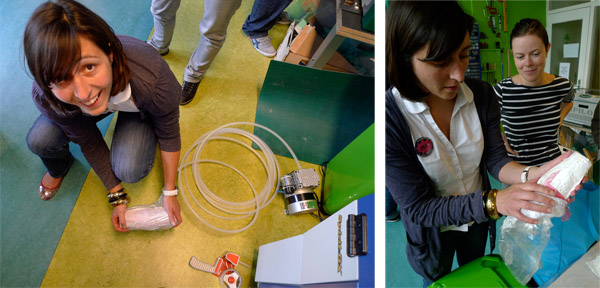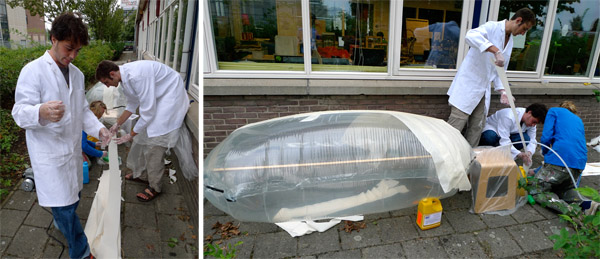Rapid prototyping with green composites
September 4th, 2010Tags: composite, composite lay-up, fab6, fablab, green composite, protospace, workshop
At the latest Fablab conference, this time hosted at the Waag in Amsterdam, I taught another workshop on (semi) green composites. Using vacuum bagging techniques, linen, cotton and rayon fabrics and polyurethane plastics, we built boxes, antennas and boats.

Much of the FabLab meetings are about sharing processes and methods for making things with each other. Here Chrissy from Manchester is simply getting to know the process of vacuum bagging: making a mould, covering it with resin-impregnated fabric, release film, a bleeder mat and a vacuum bag, and then sucking it all together with a pump.

FabFi is a FabLab project focussed on making directional antennas and sharing systems to beam internet to places that are otherwise hard to wire up. The larger dishes are currently quite heavy and difficult to carry up telephone poles and mountains… as things are… so an experiment into making things lighter, with Kelly from South Africa.

The ProtoSpace lab has been running programs on making 3D-printers of their own designs called Ultimakers. The tried to make a green composite flight case for one, but we were a bit lacking in the vacuum department to make it happen.

Finally, in anticipation of the Fab6 boat competition, Keith Berkoben started a boat building project, with an inflatable mould and hand lay-up of cotton strips. I think they might have made a big mess outside Protospace, but I wasn’t there to see the end of the manufacturing process. I did however see a capsized Amy swim up to Keith and capsize HIS boat.

Image by Ton Zijlstra.
